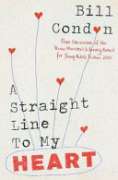
A Straight Line to My Heart
Written by Bill Condon
Allen & Unwin, 2011, 216 pp.
ISBN: 9781742377308
A Straight Line to My Heart has been recognized by two major Australian awards. In 2012, the Children’s Book Council of Australia (CBCA) bestowed an honor award in the mature readers category and it was on the young adult short list for the 2012 Prime Minister’s Literary Award. Both awards recognize range of excellent books that appeal to different age groups from early childhood, younger, and older with the Prime Minister’s Award being fairly new as it was established in 2008.
As an excellent example of contemporary realistic fiction, A Straight Line to My Heart is about a girl, Tiff (Short for Tiffany) who lives in small town, Gungee Creek. The central theme of this story is family, which is uniquely realistic. Tiff describes their atypical family history as “kind of twisty-turny” (p. 13). Stories of people in Tiff’s life illustrate life normality through abnormality. Three family members are not biologically related but care for and love each other like most families. Tiff’s mum passed away when Tiff was born and had only one sister Debbie, who couldn’t take care of the baby. Therefore, Debbie’s friends, Reggie and his wife, Nell, raised her. Nell was married before to somebody else. When she moved in with Reggie, her son, Bull, also joined as “the package deal” (p. 13). Bull was twenty-two when Tiff joined this family. Tiff recalls, “I think it was only a stop-gap fostering thing at first, but I was probably a really cute baby, so I stayed” (p. 13). The narrating point of view is Tiff’s being almost grown up. She just finished school “forever” and the new chapter in her life is about to start. A big transition is waiting for her.
In the book, Tiff has largely three units of relationships. First, she has a great loving family relationship with two men, old and young, Reggie and Bull. Also there is awkward relationship with Bull’s girlfriend, Zoe who is uncomfortable with Tiff until the midpoint of the book. Another unit is her best friend, Kayla, and her family. Best friends, Tiff and Kayla have known each other since they were 9 years old. Kayla’s family is also nontraditional. Tiff introduces Kayla’s mother as someone who has “a tribe of kids” involving two or three different fathers. Tiff also has a cute yet subtle romance with a young man, Davey, whom readers meet at the beginning of the book and discover with Tiff at the end. The third relationship is Tiff’s first boss, Shark, at the local paper, The Eagle. Tiff’s journey in her new job helps her to grow and mature through different experiences with people and journalists’ tasks. The story mirrors life honestly and humorously. Readers will taste richly portrayed colors of emotions through Tiff’s family and friends. Australian English language and contemporary Australian youth language will offer literary Aussie experience to the readers in the U.S. Also, the local setting like Gungee Creek invites readers to think about regional diversity in Australia beyond big cities like Sydney or Melbourne.
Author, Bill Condon, is a well-known Australian author. A Straight Line to My Heart is not his first book to be recognized by CBCA (Children’s Book Council of Australia—Australia’s book of the year) and the Prime Minister’s Literary Award. Previously his other books have won or been honored by other children’s literature awards in Australia. Condon is not only a YA book author but also playwright, poet, and previously newspaper journalist. Descriptive episodes in Tiff’s new job at the local newspaper, The Eagle, reflect the author’s journalist background. Young people’s nontraditional family stories can be experienced in other books like Tupac and D Foster by Jacqueline Woodson (2010), One for Murphys by Linda Hunt (2013), Locomotion by Jacqueline Woodson (2010), and The Lily Pond by Annika Thor (2011). These books illustrate foster family dynamics through different styles and issues. Some are highly focused on the discomforting side of being a foster child and some are looking at the journey to be accepted and accepting what family is. Across the books, young people discover their agency and self-empowerment through the theme of family despite thir family history being kind of “twisty and turny” (p. 13).
Yoo Kyung Sung, University of New Mexico, Albuquerque, NM
WOW Review, Volume VI, Issue 2 by Worlds of Words is licensed under a Creative Commons Attribution-NonCommercial-ShareAlike 4.0 International License. Based on work at https://wowlit.org/on-line-publications/review/vi-2/
